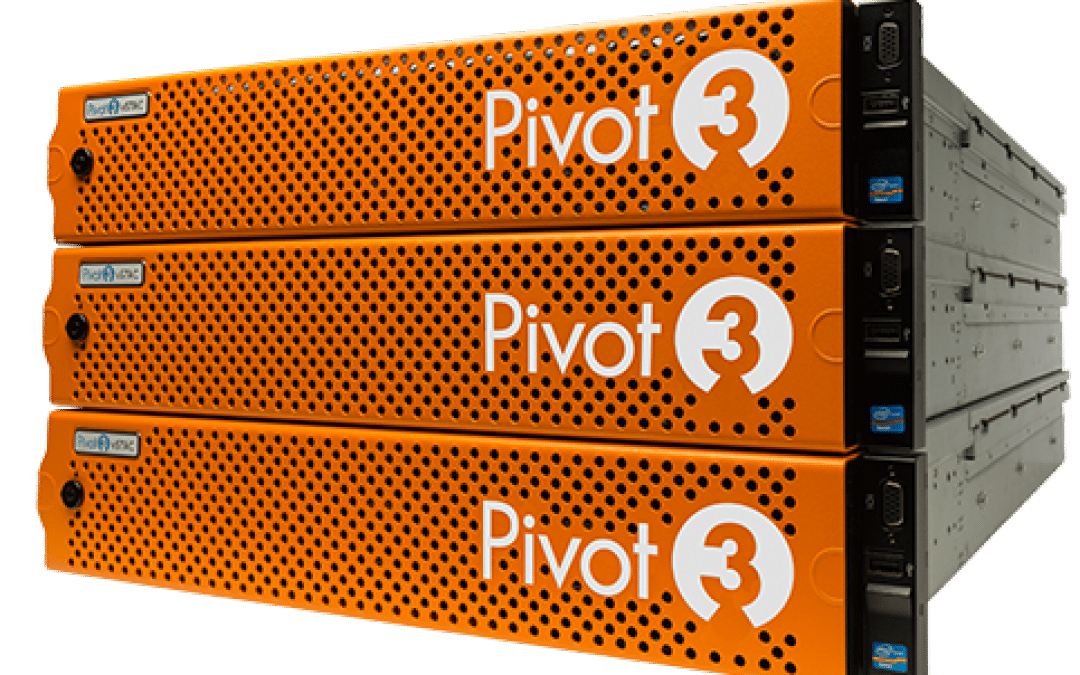Top Rated CMPs – Landscape Report 2019 announced
Pivot3’s journey into HCI began before the word “hyper-converged” even became a term. Evolving from a software-defined software solution that was devised by the company almost 15 years ago, they first released a simple-to-deploy storage appliance specifically suited for the video surveillance space. This market niche had challenging storage requirements that were hard to deliver with a single product : high-performance, high-capacity, high-availability and high-efficiency. From that single use-case Pivot3 evolved over time with the evolving needs of its customers and the storage solutions grew broader in scope.
Built on the vast experience that the company had acquired over many years and following the acquisition of NexGen’s proprietary technology early 2016, Pivot3 started to design a next-generation HCI platform named “Acuity”. Pivot3 Acuity successfully combines elements of NexGen’s N5 OS with its own proven vSTAC OS. The platform is meant to meet modern business demands through a set of attributes referred to as “power of 3”:
– Fast, by delivering accelerated performance
– Simple, by providing easy-to-use policy-based management
– Smart, by leveraging priority-aware intelligence
Based on these characteristics Acuity enables organizations to support multiple mixed workloads, deliver predictable performance in hybrid clouds and automate resource management. But how does Acuity actually fulfill that promise?
For starters, Acuity was architected from the ground up with NVMe flash storage in mind (see boxed text down the end of the article for performance info on NVMe flash). This way it would be able to leverage the features and performance of the latest generation storage technology without having to optimize for it first. To prove its point, Pivot3 recently released performance benchmarks that showed the advantages of its architecture over some of its competitors. In order to avoid any confusion, it’s probably also good to mention that Pivot3 does not make use of any proprietary PCIe card but leverages industry standard PCIe-based NVMe Flash devices.
Secondly, Acuity comes with pre-defined performance policies out-of-the-box that manage multiple performance attributes: IOPS, Latency (milliseconds) and Throughput (MB/s). The unique offset here is, that Acuity’s Quality-of-Service (QoS) mechanism aims to guarantee storage performance for all workloads instead of limiting storage performance for some. This, according to Pivot3, is the only real method to empower the IT department to meet strict service level agreements. The pre-defined service levels govern how the QoS engine treats the targets in order to maintain Mission Critical performance, then Business Critical performance and then Non-critical performance. This, off course, happens fully automatically. Once a QoS policy has been applied to a storage volume, it can be changed manually on-the-fly or automatically by configuring and assigning schedules. This makes the QoS implementation highly flexible in nature and versatile to changing business needs.
The Pivot3 Acuity portfolio, dubbed the X5-series, contains both hybrid and all-flash appliances. In each category there are two appliances node types to choose from: the “accelerator” node has an NVMe PCIe card onboard, while the “non-accelerator” node does not have an NVMe PCIe card onboard. Each Acuity cluster always requires two accelerator nodes so incoming writes to the cluster can be protected. The “Global caching” enables non-accelerator nodes within the cluster to also benefit from fast reads.
Does this mean the platform is perfect in its current iteration? Actually, as with most other newly launched SDS/HCI platforms, there is still some base functionality we’d like to see added. Pivot3 Acuity X5-series currently lacks stretched clustering capabilities. This means the solution at present cannot be leveraged in a localized dual-datacenter HA environment. The same applies to file services and public cloud integration; both are not natively included in the present Pivot3 Acuity version. Lastly, if VM-centric storage management is being considered a big plus, at present you’re out of luck. Because Pivot3 Acuity is a block-based storage platform that does not (yet) support VVOL integration, granularity is still restricted to storage volumes. However, in the end it entirely depends on your use case whether Pivot3 Acuity in its present state fits the proverbial bill. If you primarily aim for a fast, simple and smart SDS/HCI solution, then you probably should seriously consider Pivot3 Acuity.
Want to know more about Pivot3 Acuity platform specifics? Then please hop over to our SDS/HCI category comparison page right now, as Pivot3 Acuity has just been added to our detailed comparison listing.
NVMe PCIe performance metrics The NVMe PCIe cards used in the Pivot3 Acuity appliances do pack a punch. The cards sport an 850,000 IOPS rating and a 4.5+ GB/s throughput rating. This is about twice the performance of a 12Gbps SAS SSD and six times the performance of a 6Gbps SATA SSD. The latency of NVMe PCIe cards used in Actuity is also quite lower, close to 0.3ms in contrast to about 0.8ms for SATA SSDs. |
Herman Rutten – WhatMatrix Lead Category Consultant [SDS & HCI]
For updates to our comparisons follow us on twitter: @What_Matrix
About Pivot3
Pivot3 enables organizations to build and operate efficient and resilient multi-cloud architectures with industry-leading hyperconverged infrastructure technology so they can focus on the applications and services that power their business. Pivot3 HCI software platforms natively combine storage, compute, networking and virtualization into a highly-resilient, software-defined solution with machine intelligence to automate and orchestrate the seamless mobility of application workloads between the datacenter and the cloud with guaranteed performance. With over 2,500 customers in 54 countries, and 18,000 deployments in multiple industries such as healthcare, government, transportation, security, entertainment, education, gaming and retail, Pivot3 is defining the future of autonomous cloud computing with smarter infrastructure solutions.

Herman Rutten

Latest posts by Herman Rutten (see all)
- StarWind HyperConverged Appliance enters the WhatMatrix - December 3, 2019
- SDS & HCI Updates: Nutanix, NetApp, vSAN, HPE - September 3, 2019
- WhatMatrix adds Scale Computing HC3 to SDS/HCI Lineup - June 5, 2019






